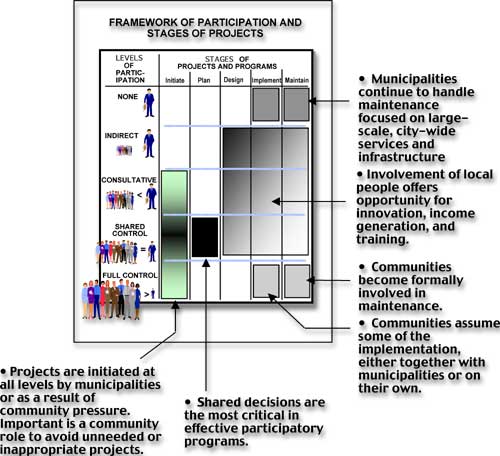|

|

Getting Started: Project Context
At What Stage and Level Should Participation Occur?
|
|
A Model for Participation
|
Source:
Action Planning for Cities. Nabeel Hamdi and Reinhard Goethert, John Wiley & Sons, Chichester 1997. Pg. 77.
|
|
Each stage of a project involves the community and the city in a relationship which best serves their mutual interests. The bias is on decision making and delivery of agreed outputs. Therefore, the key to effective planning with communities is shared control in plan-making, as illustrated in the chart below.
The chart relates the level of involvement and the recommended forms of participation: |
 The Initiation stage may be at the Consultative, Shared control, or Full control level. The underlying requirement is that the community has a role in all cases, and can take the initiative if needed. It is bottom-up biased since the community would be the direct initiator and recipient of the action. The Initiation stage may be at the Consultative, Shared control, or Full control level. The underlying requirement is that the community has a role in all cases, and can take the initiative if needed. It is bottom-up biased since the community would be the direct initiator and recipient of the action.
|
 The Plan stage is seen as the most crucial for the community and the city to be jointly involved. This is the stage at which key decisions are taken and the full project programme is defined. Communities have the choice of further active involvement, for example as in implementation to lower costs, or they may choose to share responsibilities, or even not to participate further. It is important that all vested interests have been considered. The Plan stage is seen as the most crucial for the community and the city to be jointly involved. This is the stage at which key decisions are taken and the full project programme is defined. Communities have the choice of further active involvement, for example as in implementation to lower costs, or they may choose to share responsibilities, or even not to participate further. It is important that all vested interests have been considered.
|
 The Design stage is less crucial for full community involvement. However, it offers the potential advantage of inducing innovative solutions if methods and ways can be devised to involve and work effectively with communities. The tradeoff is more time intensive preparation. It also requires a change in customary practice and an acceptance that technical knowledge does not assure primacy. The Design stage is less crucial for full community involvement. However, it offers the potential advantage of inducing innovative solutions if methods and ways can be devised to involve and work effectively with communities. The tradeoff is more time intensive preparation. It also requires a change in customary practice and an acceptance that technical knowledge does not assure primacy.
|
 The Implementation stage is also less critical, but it should not be seen as rationalizing the ‘cheap labor’ myth. In some cases implementation is better carried out by the city authorities, particularly when large machinery is necessary or because of technical complexity. Implementation may be programmed as income generation and when direct involvement by the community becomes important, or for skills training. The Implementation stage is also less critical, but it should not be seen as rationalizing the ‘cheap labor’ myth. In some cases implementation is better carried out by the city authorities, particularly when large machinery is necessary or because of technical complexity. Implementation may be programmed as income generation and when direct involvement by the community becomes important, or for skills training.
|
 At the Maintenance stage both city and community are involved. Each participates according to where and what it can best contribute. In some cases communities can provide labor and shift funds saved to other uses. Alternatively, hiring of local people can be a means of pumping income into a community. Garbage collection is a larger area activity but also a community activity. Day-to-day maintenance of school buildings can readily be managed by community members, while major repairs often require significant financial resources and technical skills. Clear, definite tasks must be agreed and a realistic assessment of capacity must be made for shared maintenance to be successful. At the Maintenance stage both city and community are involved. Each participates according to where and what it can best contribute. In some cases communities can provide labor and shift funds saved to other uses. Alternatively, hiring of local people can be a means of pumping income into a community. Garbage collection is a larger area activity but also a community activity. Day-to-day maintenance of school buildings can readily be managed by community members, while major repairs often require significant financial resources and technical skills. Clear, definite tasks must be agreed and a realistic assessment of capacity must be made for shared maintenance to be successful.
|
|
See also:
Tools: Interactive Community Planning |
 |
|
|

